System Analysis and Design
VerifiedAdded on 2023/04/03
|15
|1095
|381
AI Summary
This report provides a detailed analysis of the system operations of Air Australia and the design of the information system. It includes use case diagrams, data flow diagrams, and entity relationship diagrams.
Contribute Materials
Your contribution can guide someone’s learning journey. Share your
documents today.
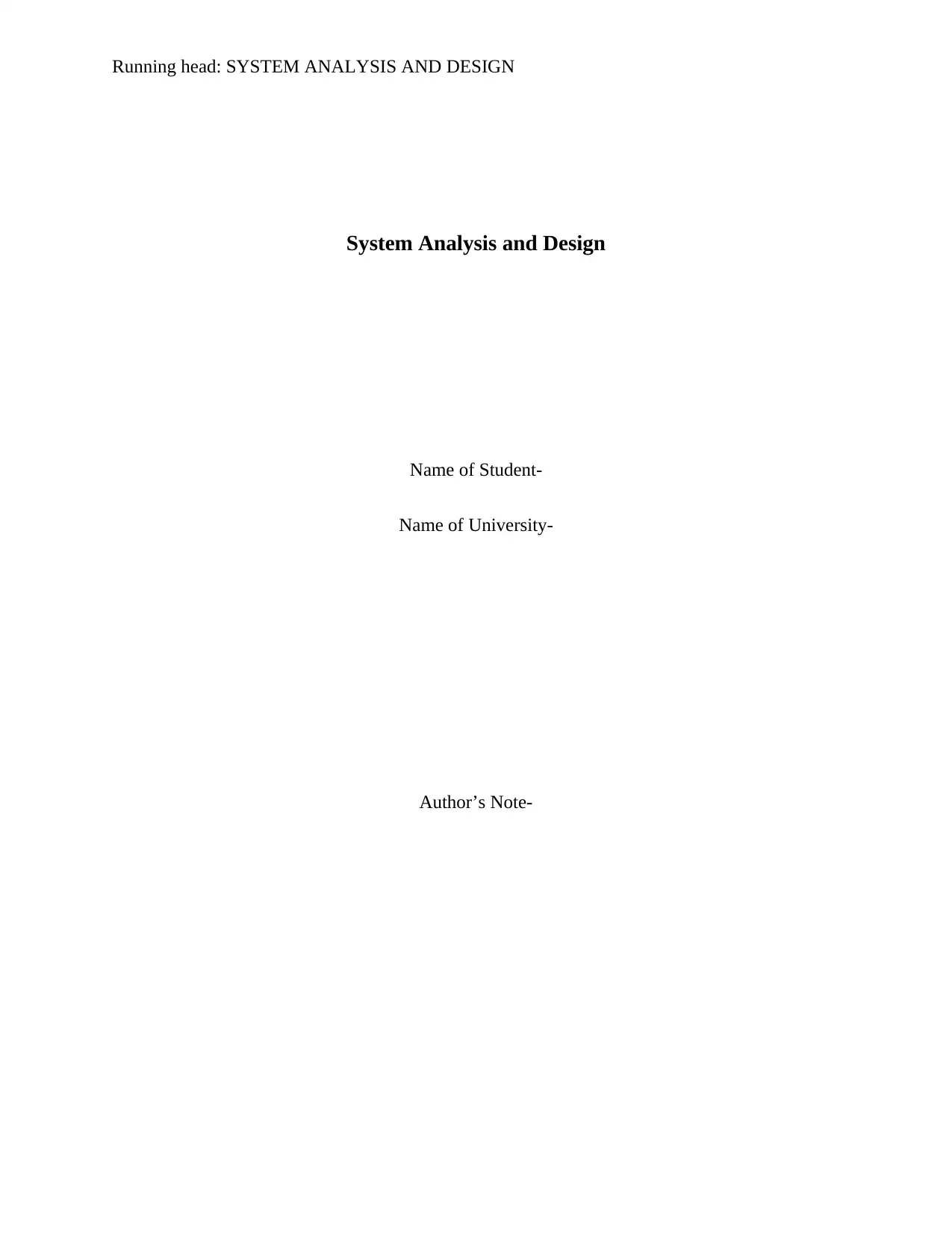
Running head: SYSTEM ANALYSIS AND DESIGN
System Analysis and Design
Name of Student-
Name of University-
Author’s Note-
System Analysis and Design
Name of Student-
Name of University-
Author’s Note-
Secure Best Marks with AI Grader
Need help grading? Try our AI Grader for instant feedback on your assignments.
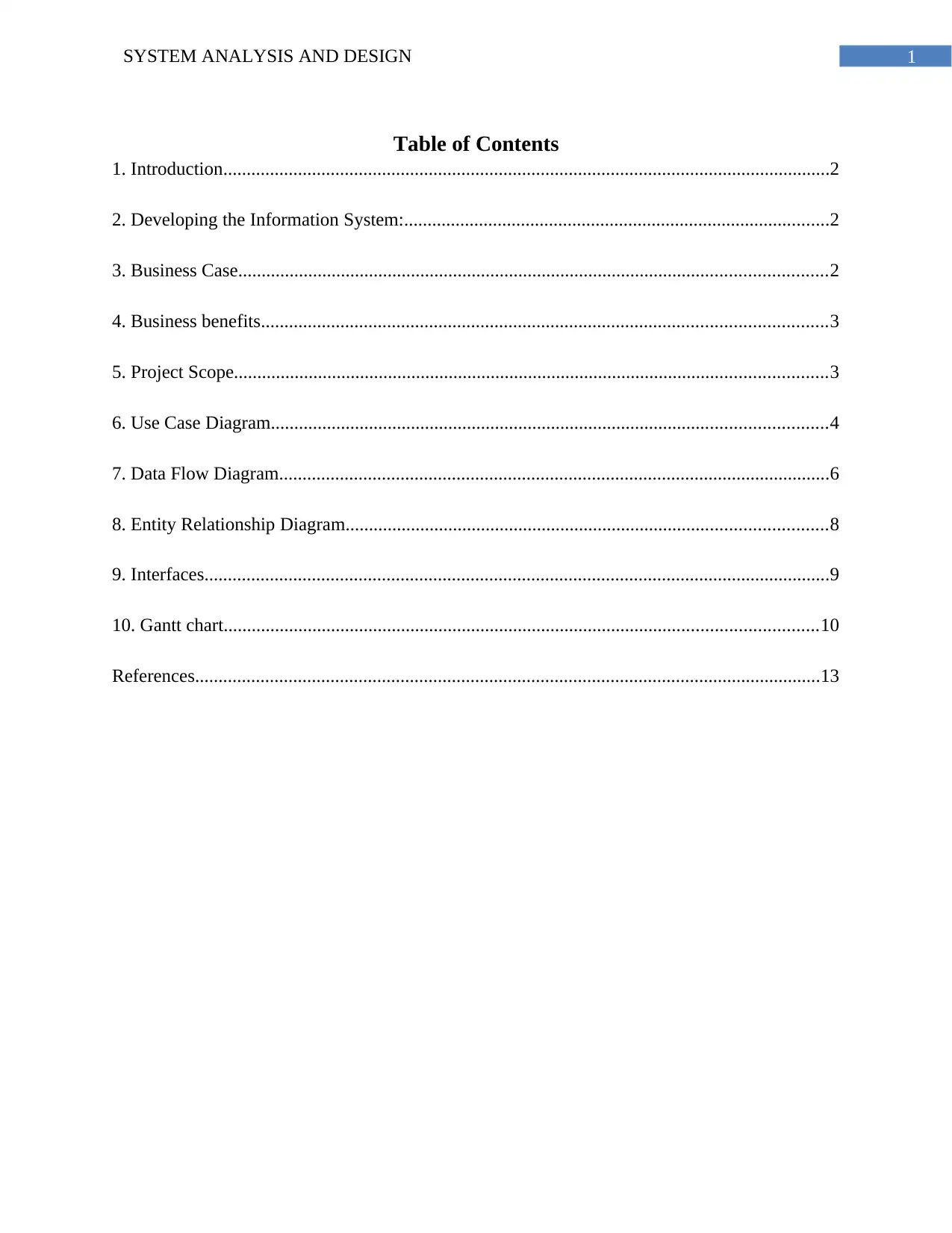
1SYSTEM ANALYSIS AND DESIGN
Table of Contents
1. Introduction..................................................................................................................................2
2. Developing the Information System:...........................................................................................2
3. Business Case..............................................................................................................................2
4. Business benefits.........................................................................................................................3
5. Project Scope...............................................................................................................................3
6. Use Case Diagram.......................................................................................................................4
7. Data Flow Diagram......................................................................................................................6
8. Entity Relationship Diagram.......................................................................................................8
9. Interfaces......................................................................................................................................9
10. Gantt chart...............................................................................................................................10
References......................................................................................................................................13
Table of Contents
1. Introduction..................................................................................................................................2
2. Developing the Information System:...........................................................................................2
3. Business Case..............................................................................................................................2
4. Business benefits.........................................................................................................................3
5. Project Scope...............................................................................................................................3
6. Use Case Diagram.......................................................................................................................4
7. Data Flow Diagram......................................................................................................................6
8. Entity Relationship Diagram.......................................................................................................8
9. Interfaces......................................................................................................................................9
10. Gantt chart...............................................................................................................................10
References......................................................................................................................................13
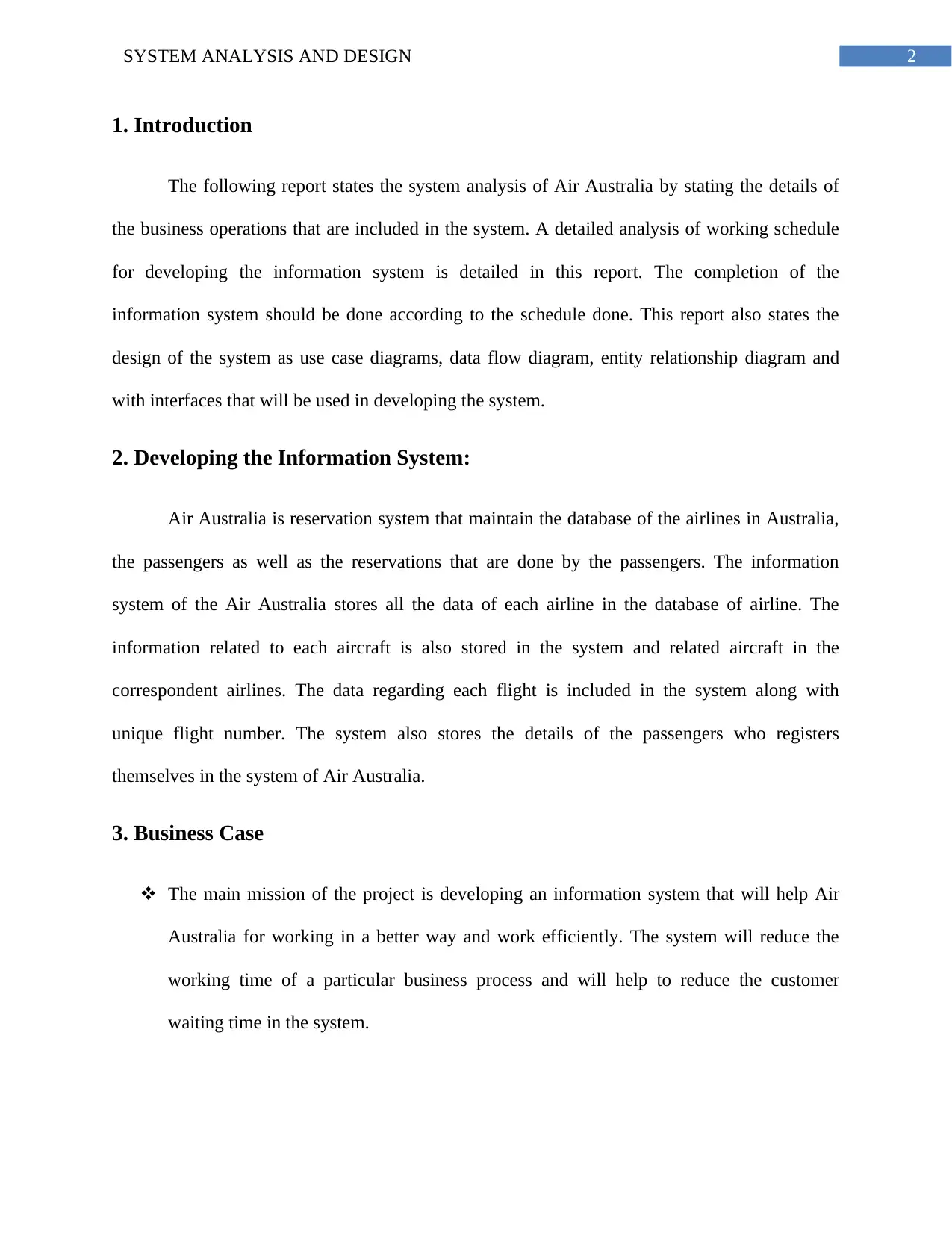
2SYSTEM ANALYSIS AND DESIGN
1. Introduction
The following report states the system analysis of Air Australia by stating the details of
the business operations that are included in the system. A detailed analysis of working schedule
for developing the information system is detailed in this report. The completion of the
information system should be done according to the schedule done. This report also states the
design of the system as use case diagrams, data flow diagram, entity relationship diagram and
with interfaces that will be used in developing the system.
2. Developing the Information System:
Air Australia is reservation system that maintain the database of the airlines in Australia,
the passengers as well as the reservations that are done by the passengers. The information
system of the Air Australia stores all the data of each airline in the database of airline. The
information related to each aircraft is also stored in the system and related aircraft in the
correspondent airlines. The data regarding each flight is included in the system along with
unique flight number. The system also stores the details of the passengers who registers
themselves in the system of Air Australia.
3. Business Case
The main mission of the project is developing an information system that will help Air
Australia for working in a better way and work efficiently. The system will reduce the
working time of a particular business process and will help to reduce the customer
waiting time in the system.
1. Introduction
The following report states the system analysis of Air Australia by stating the details of
the business operations that are included in the system. A detailed analysis of working schedule
for developing the information system is detailed in this report. The completion of the
information system should be done according to the schedule done. This report also states the
design of the system as use case diagrams, data flow diagram, entity relationship diagram and
with interfaces that will be used in developing the system.
2. Developing the Information System:
Air Australia is reservation system that maintain the database of the airlines in Australia,
the passengers as well as the reservations that are done by the passengers. The information
system of the Air Australia stores all the data of each airline in the database of airline. The
information related to each aircraft is also stored in the system and related aircraft in the
correspondent airlines. The data regarding each flight is included in the system along with
unique flight number. The system also stores the details of the passengers who registers
themselves in the system of Air Australia.
3. Business Case
The main mission of the project is developing an information system that will help Air
Australia for working in a better way and work efficiently. The system will reduce the
working time of a particular business process and will help to reduce the customer
waiting time in the system.
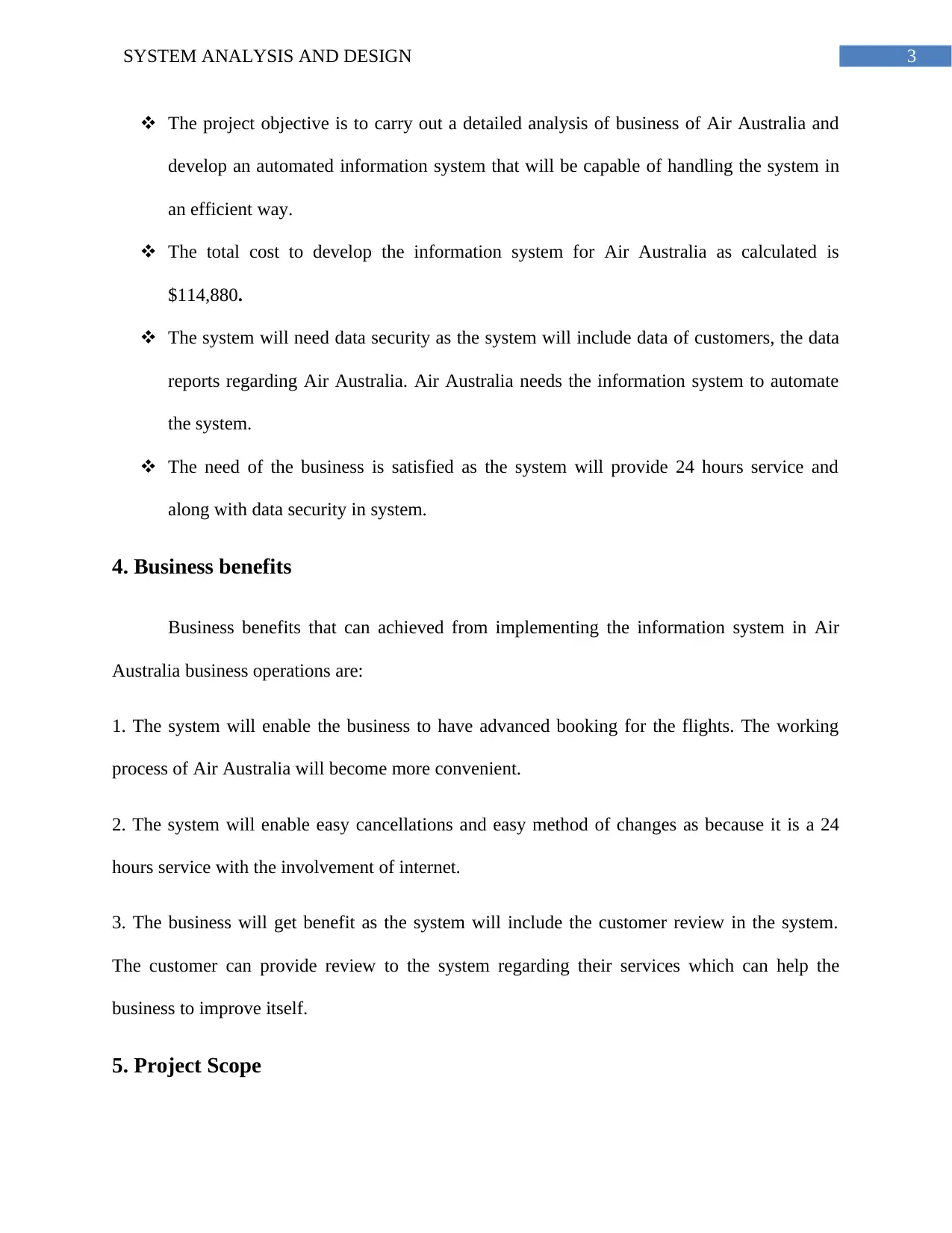
3SYSTEM ANALYSIS AND DESIGN
The project objective is to carry out a detailed analysis of business of Air Australia and
develop an automated information system that will be capable of handling the system in
an efficient way.
The total cost to develop the information system for Air Australia as calculated is
$114,880.
The system will need data security as the system will include data of customers, the data
reports regarding Air Australia. Air Australia needs the information system to automate
the system.
The need of the business is satisfied as the system will provide 24 hours service and
along with data security in system.
4. Business benefits
Business benefits that can achieved from implementing the information system in Air
Australia business operations are:
1. The system will enable the business to have advanced booking for the flights. The working
process of Air Australia will become more convenient.
2. The system will enable easy cancellations and easy method of changes as because it is a 24
hours service with the involvement of internet.
3. The business will get benefit as the system will include the customer review in the system.
The customer can provide review to the system regarding their services which can help the
business to improve itself.
5. Project Scope
The project objective is to carry out a detailed analysis of business of Air Australia and
develop an automated information system that will be capable of handling the system in
an efficient way.
The total cost to develop the information system for Air Australia as calculated is
$114,880.
The system will need data security as the system will include data of customers, the data
reports regarding Air Australia. Air Australia needs the information system to automate
the system.
The need of the business is satisfied as the system will provide 24 hours service and
along with data security in system.
4. Business benefits
Business benefits that can achieved from implementing the information system in Air
Australia business operations are:
1. The system will enable the business to have advanced booking for the flights. The working
process of Air Australia will become more convenient.
2. The system will enable easy cancellations and easy method of changes as because it is a 24
hours service with the involvement of internet.
3. The business will get benefit as the system will include the customer review in the system.
The customer can provide review to the system regarding their services which can help the
business to improve itself.
5. Project Scope
Secure Best Marks with AI Grader
Need help grading? Try our AI Grader for instant feedback on your assignments.
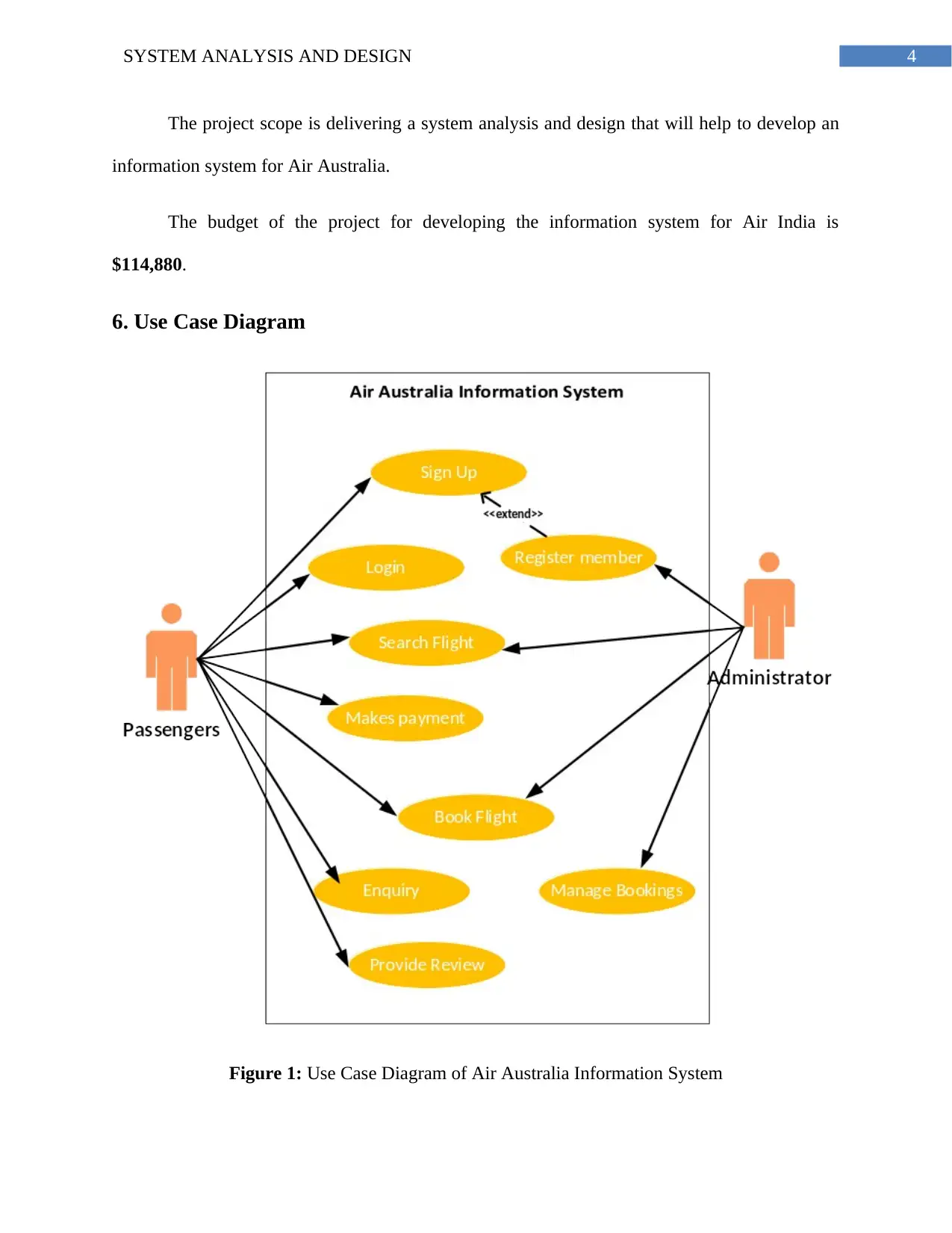
4SYSTEM ANALYSIS AND DESIGN
The project scope is delivering a system analysis and design that will help to develop an
information system for Air Australia.
The budget of the project for developing the information system for Air India is
$114,880.
6. Use Case Diagram
Figure 1: Use Case Diagram of Air Australia Information System
The project scope is delivering a system analysis and design that will help to develop an
information system for Air Australia.
The budget of the project for developing the information system for Air India is
$114,880.
6. Use Case Diagram
Figure 1: Use Case Diagram of Air Australia Information System
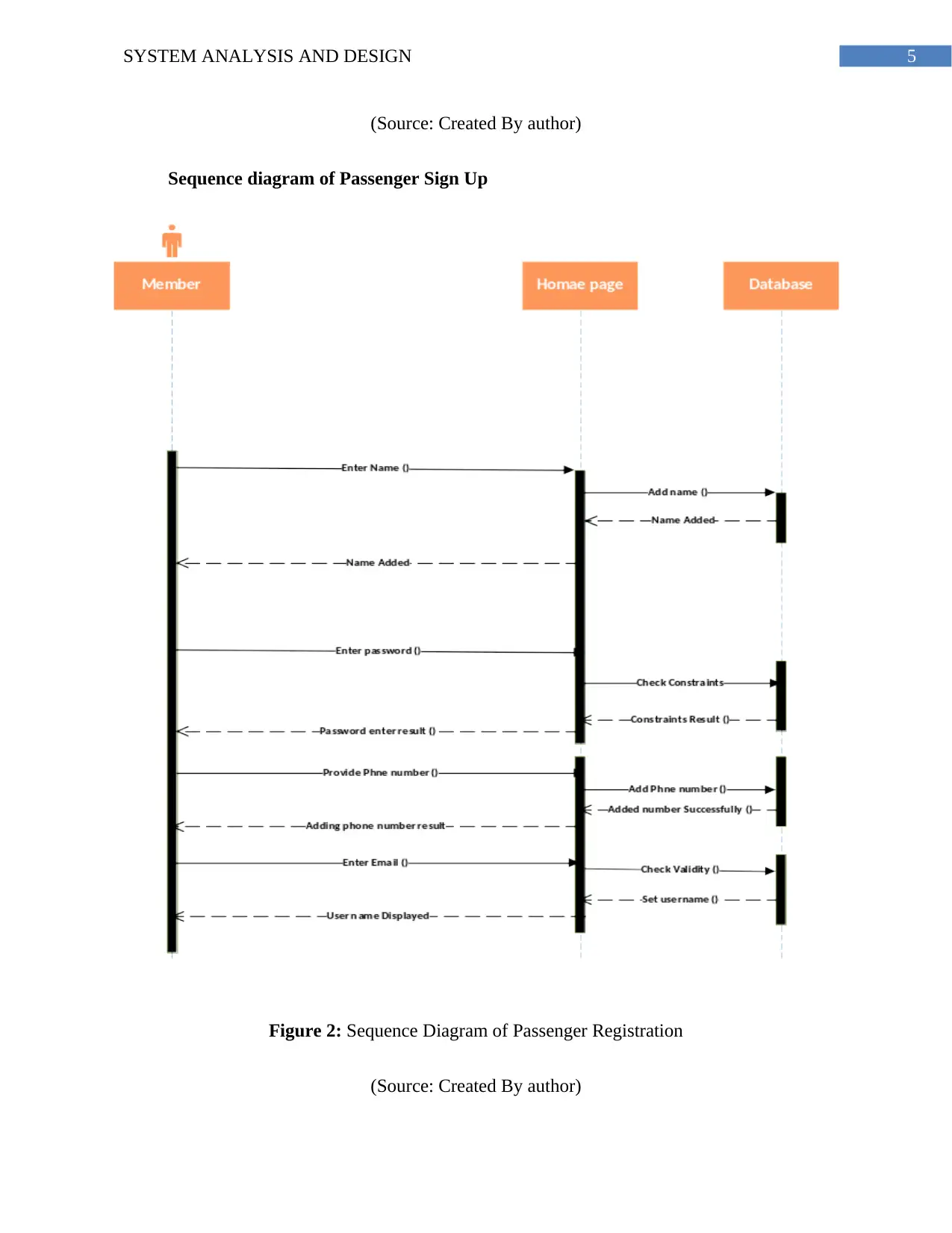
5SYSTEM ANALYSIS AND DESIGN
(Source: Created By author)
Sequence diagram of Passenger Sign Up
Figure 2: Sequence Diagram of Passenger Registration
(Source: Created By author)
(Source: Created By author)
Sequence diagram of Passenger Sign Up
Figure 2: Sequence Diagram of Passenger Registration
(Source: Created By author)

6SYSTEM ANALYSIS AND DESIGN
Paraphrase This Document
Need a fresh take? Get an instant paraphrase of this document with our AI Paraphraser
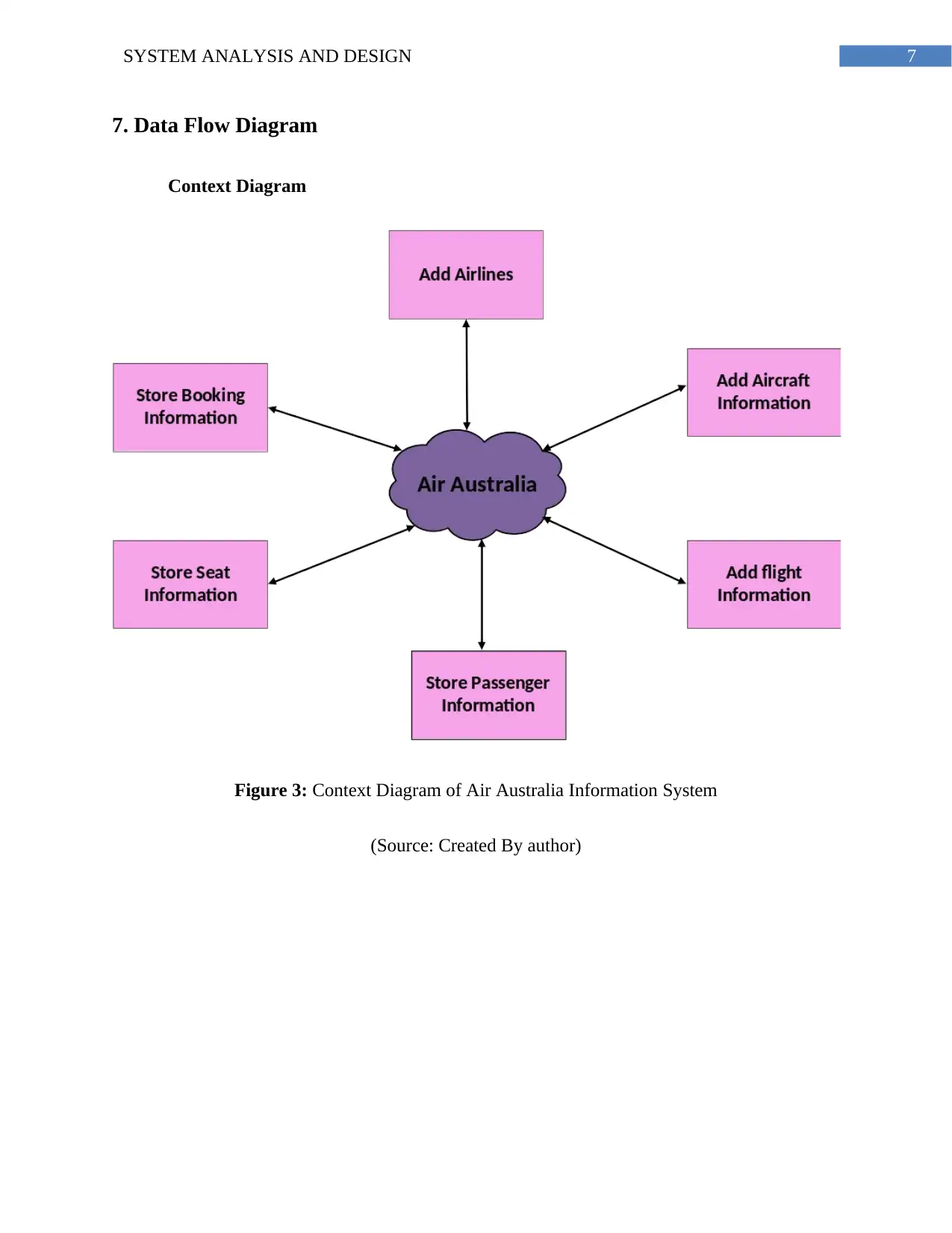
7SYSTEM ANALYSIS AND DESIGN
7. Data Flow Diagram
Context Diagram
Figure 3: Context Diagram of Air Australia Information System
(Source: Created By author)
7. Data Flow Diagram
Context Diagram
Figure 3: Context Diagram of Air Australia Information System
(Source: Created By author)
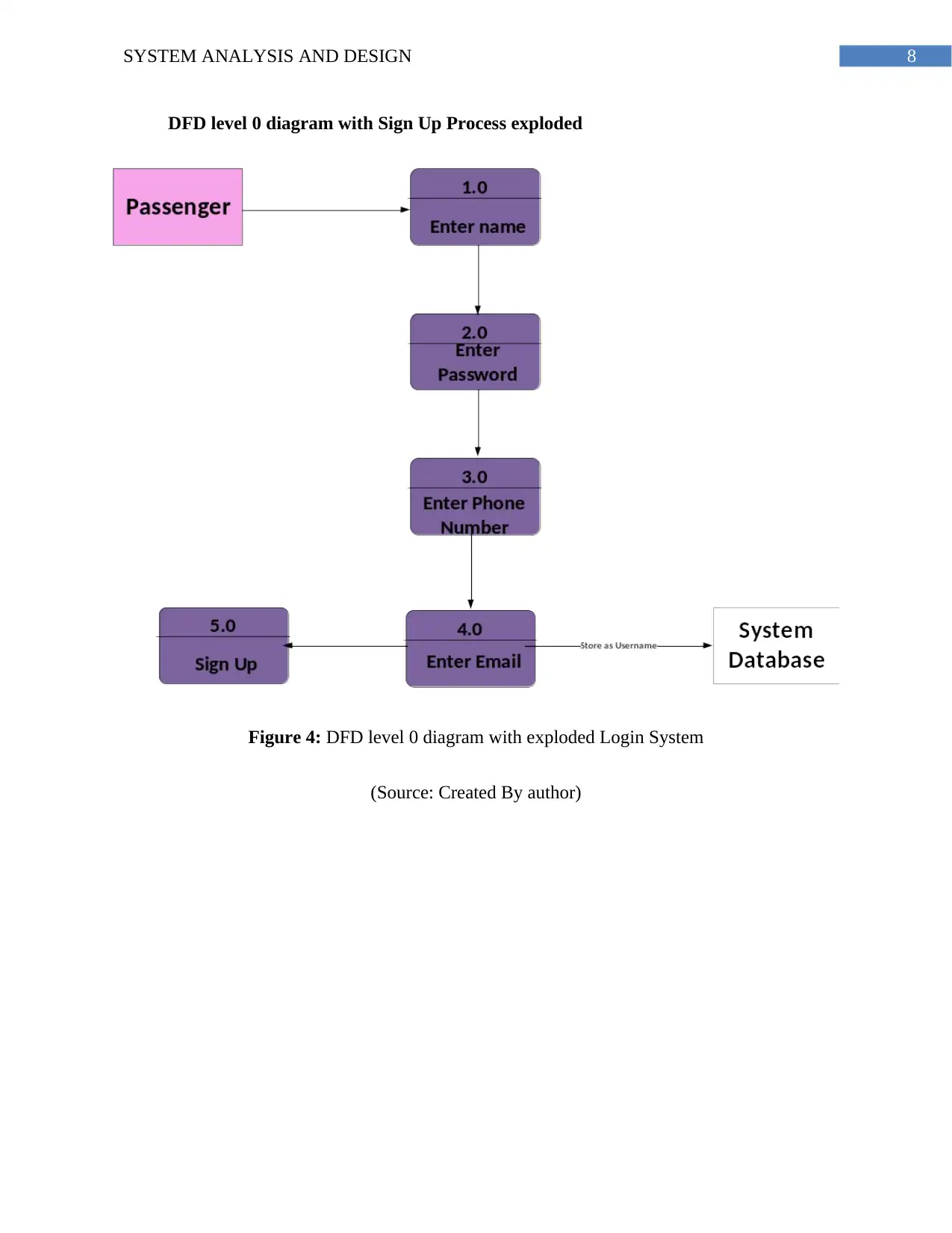
8SYSTEM ANALYSIS AND DESIGN
DFD level 0 diagram with Sign Up Process exploded
Figure 4: DFD level 0 diagram with exploded Login System
(Source: Created By author)
DFD level 0 diagram with Sign Up Process exploded
Figure 4: DFD level 0 diagram with exploded Login System
(Source: Created By author)
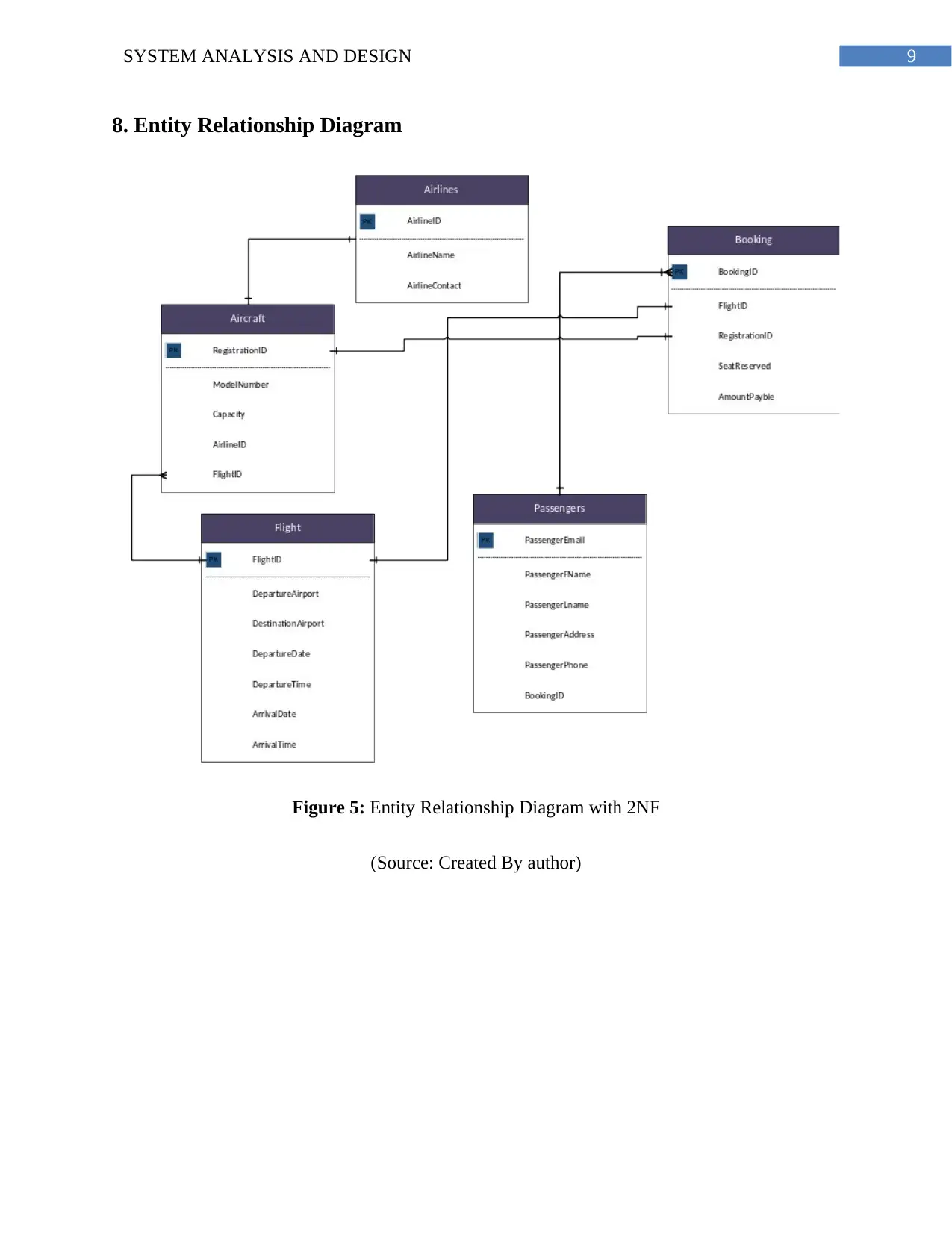
9SYSTEM ANALYSIS AND DESIGN
8. Entity Relationship Diagram
Figure 5: Entity Relationship Diagram with 2NF
(Source: Created By author)
8. Entity Relationship Diagram
Figure 5: Entity Relationship Diagram with 2NF
(Source: Created By author)
Secure Best Marks with AI Grader
Need help grading? Try our AI Grader for instant feedback on your assignments.
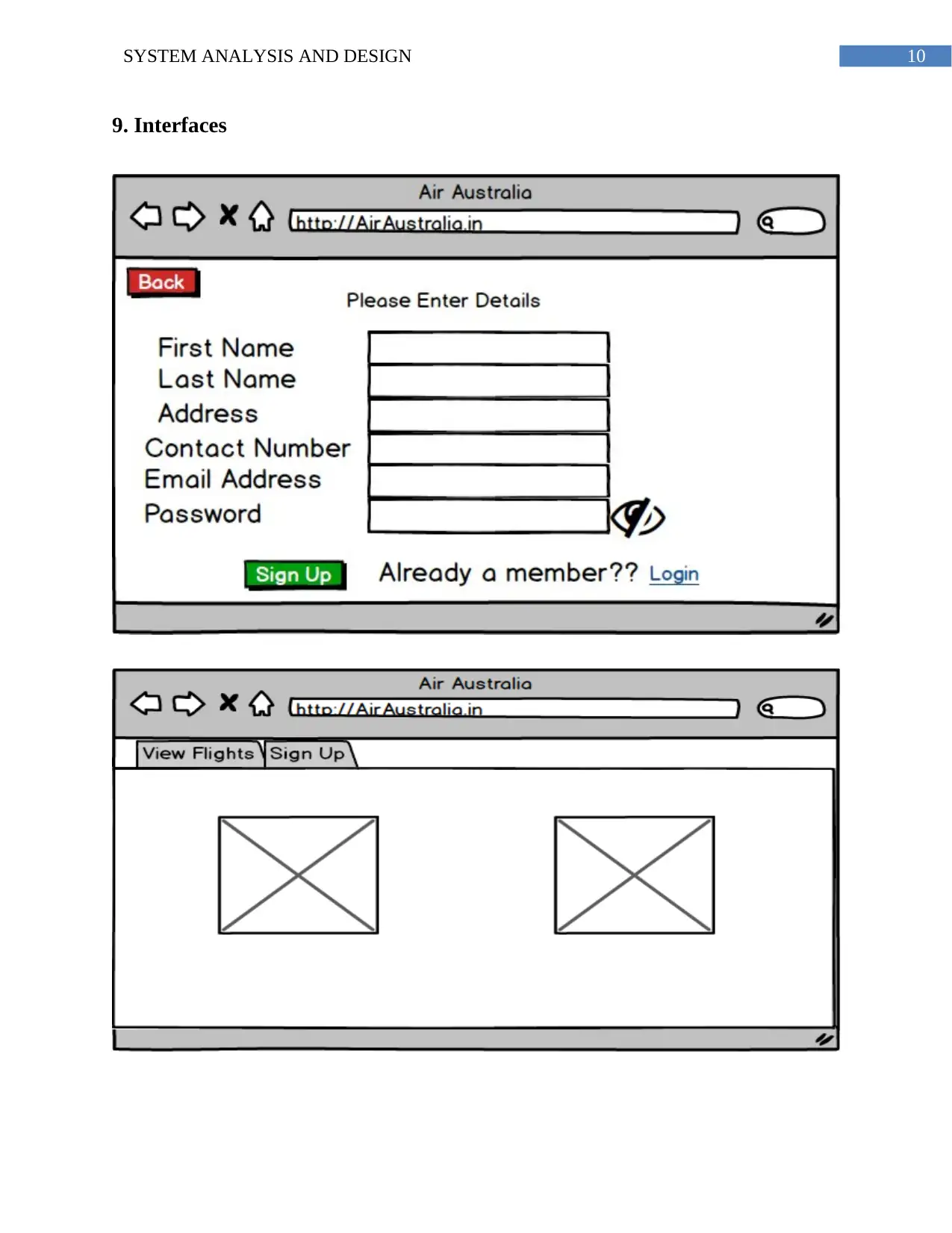
10SYSTEM ANALYSIS AND DESIGN
9. Interfaces
9. Interfaces
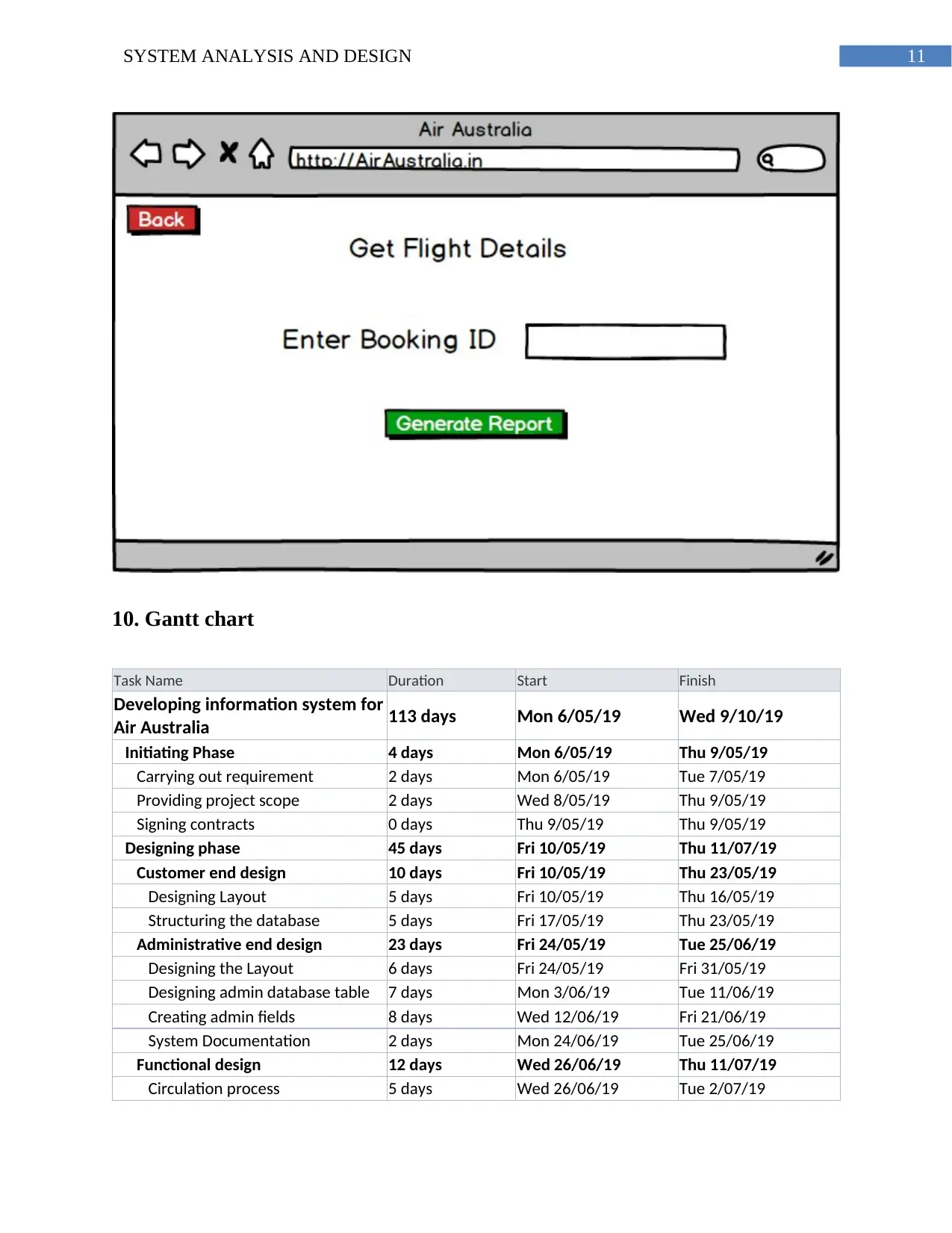
11SYSTEM ANALYSIS AND DESIGN
10. Gantt chart
Task Name Duration Start Finish
Developing information system for
Air Australia 113 days Mon 6/05/19 Wed 9/10/19
Initiating Phase 4 days Mon 6/05/19 Thu 9/05/19
Carrying out requirement 2 days Mon 6/05/19 Tue 7/05/19
Providing project scope 2 days Wed 8/05/19 Thu 9/05/19
Signing contracts 0 days Thu 9/05/19 Thu 9/05/19
Designing phase 45 days Fri 10/05/19 Thu 11/07/19
Customer end design 10 days Fri 10/05/19 Thu 23/05/19
Designing Layout 5 days Fri 10/05/19 Thu 16/05/19
Structuring the database 5 days Fri 17/05/19 Thu 23/05/19
Administrative end design 23 days Fri 24/05/19 Tue 25/06/19
Designing the Layout 6 days Fri 24/05/19 Fri 31/05/19
Designing admin database table 7 days Mon 3/06/19 Tue 11/06/19
Creating admin fields 8 days Wed 12/06/19 Fri 21/06/19
System Documentation 2 days Mon 24/06/19 Tue 25/06/19
Functional design 12 days Wed 26/06/19 Thu 11/07/19
Circulation process 5 days Wed 26/06/19 Tue 2/07/19
10. Gantt chart
Task Name Duration Start Finish
Developing information system for
Air Australia 113 days Mon 6/05/19 Wed 9/10/19
Initiating Phase 4 days Mon 6/05/19 Thu 9/05/19
Carrying out requirement 2 days Mon 6/05/19 Tue 7/05/19
Providing project scope 2 days Wed 8/05/19 Thu 9/05/19
Signing contracts 0 days Thu 9/05/19 Thu 9/05/19
Designing phase 45 days Fri 10/05/19 Thu 11/07/19
Customer end design 10 days Fri 10/05/19 Thu 23/05/19
Designing Layout 5 days Fri 10/05/19 Thu 16/05/19
Structuring the database 5 days Fri 17/05/19 Thu 23/05/19
Administrative end design 23 days Fri 24/05/19 Tue 25/06/19
Designing the Layout 6 days Fri 24/05/19 Fri 31/05/19
Designing admin database table 7 days Mon 3/06/19 Tue 11/06/19
Creating admin fields 8 days Wed 12/06/19 Fri 21/06/19
System Documentation 2 days Mon 24/06/19 Tue 25/06/19
Functional design 12 days Wed 26/06/19 Thu 11/07/19
Circulation process 5 days Wed 26/06/19 Tue 2/07/19
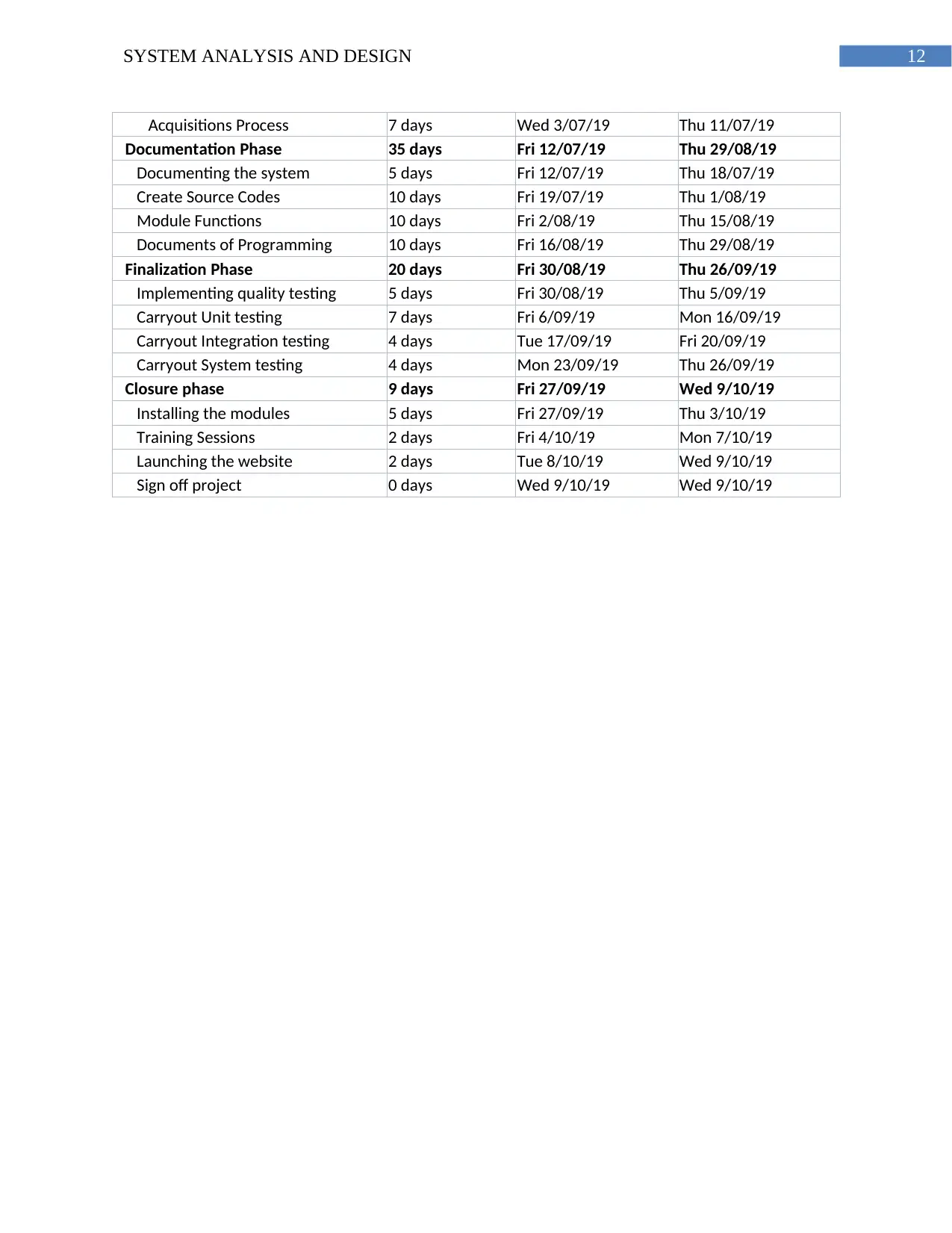
12SYSTEM ANALYSIS AND DESIGN
Acquisitions Process 7 days Wed 3/07/19 Thu 11/07/19
Documentation Phase 35 days Fri 12/07/19 Thu 29/08/19
Documenting the system 5 days Fri 12/07/19 Thu 18/07/19
Create Source Codes 10 days Fri 19/07/19 Thu 1/08/19
Module Functions 10 days Fri 2/08/19 Thu 15/08/19
Documents of Programming 10 days Fri 16/08/19 Thu 29/08/19
Finalization Phase 20 days Fri 30/08/19 Thu 26/09/19
Implementing quality testing 5 days Fri 30/08/19 Thu 5/09/19
Carryout Unit testing 7 days Fri 6/09/19 Mon 16/09/19
Carryout Integration testing 4 days Tue 17/09/19 Fri 20/09/19
Carryout System testing 4 days Mon 23/09/19 Thu 26/09/19
Closure phase 9 days Fri 27/09/19 Wed 9/10/19
Installing the modules 5 days Fri 27/09/19 Thu 3/10/19
Training Sessions 2 days Fri 4/10/19 Mon 7/10/19
Launching the website 2 days Tue 8/10/19 Wed 9/10/19
Sign off project 0 days Wed 9/10/19 Wed 9/10/19
Acquisitions Process 7 days Wed 3/07/19 Thu 11/07/19
Documentation Phase 35 days Fri 12/07/19 Thu 29/08/19
Documenting the system 5 days Fri 12/07/19 Thu 18/07/19
Create Source Codes 10 days Fri 19/07/19 Thu 1/08/19
Module Functions 10 days Fri 2/08/19 Thu 15/08/19
Documents of Programming 10 days Fri 16/08/19 Thu 29/08/19
Finalization Phase 20 days Fri 30/08/19 Thu 26/09/19
Implementing quality testing 5 days Fri 30/08/19 Thu 5/09/19
Carryout Unit testing 7 days Fri 6/09/19 Mon 16/09/19
Carryout Integration testing 4 days Tue 17/09/19 Fri 20/09/19
Carryout System testing 4 days Mon 23/09/19 Thu 26/09/19
Closure phase 9 days Fri 27/09/19 Wed 9/10/19
Installing the modules 5 days Fri 27/09/19 Thu 3/10/19
Training Sessions 2 days Fri 4/10/19 Mon 7/10/19
Launching the website 2 days Tue 8/10/19 Wed 9/10/19
Sign off project 0 days Wed 9/10/19 Wed 9/10/19
Paraphrase This Document
Need a fresh take? Get an instant paraphrase of this document with our AI Paraphraser
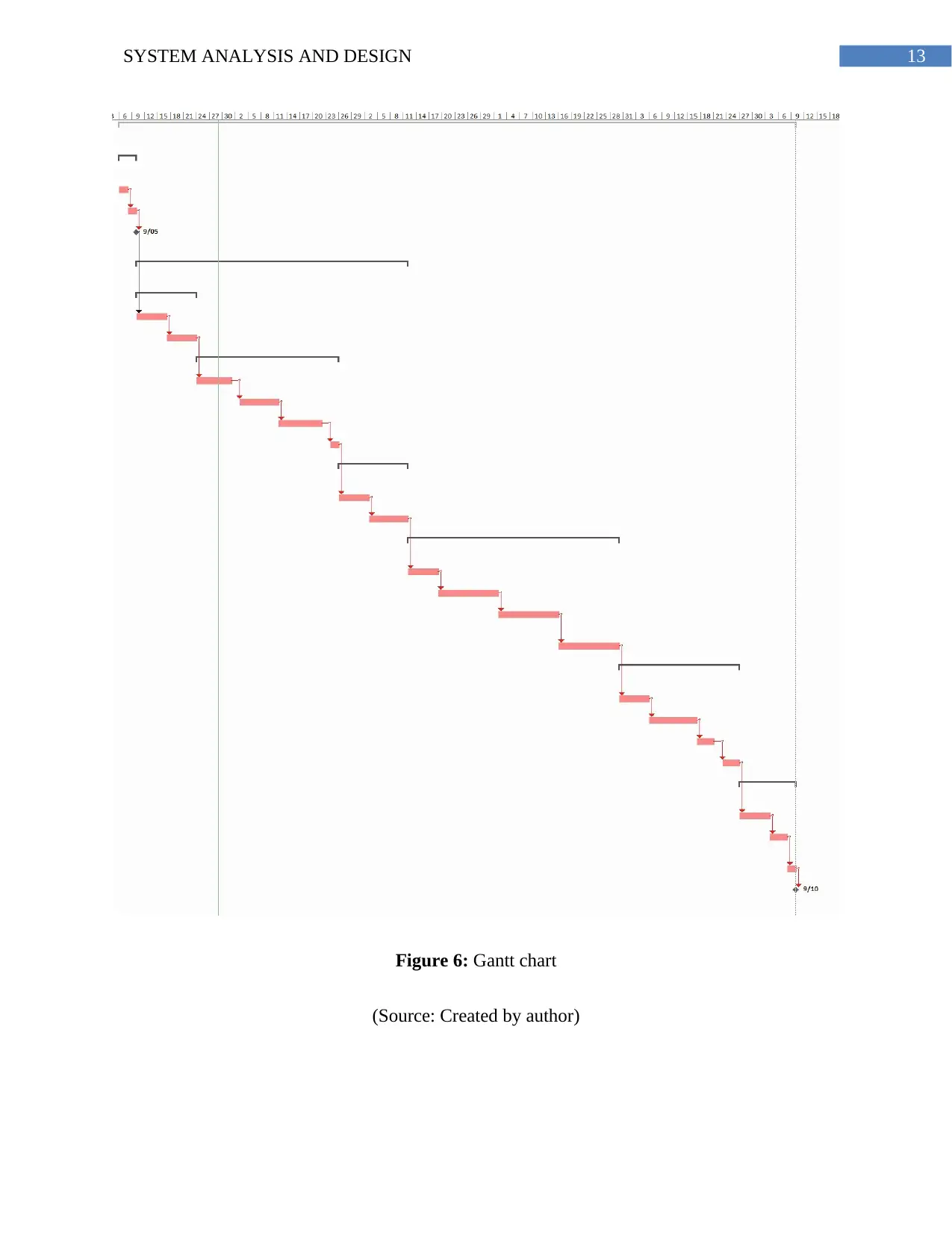
13SYSTEM ANALYSIS AND DESIGN
Figure 6: Gantt chart
(Source: Created by author)
Figure 6: Gantt chart
(Source: Created by author)
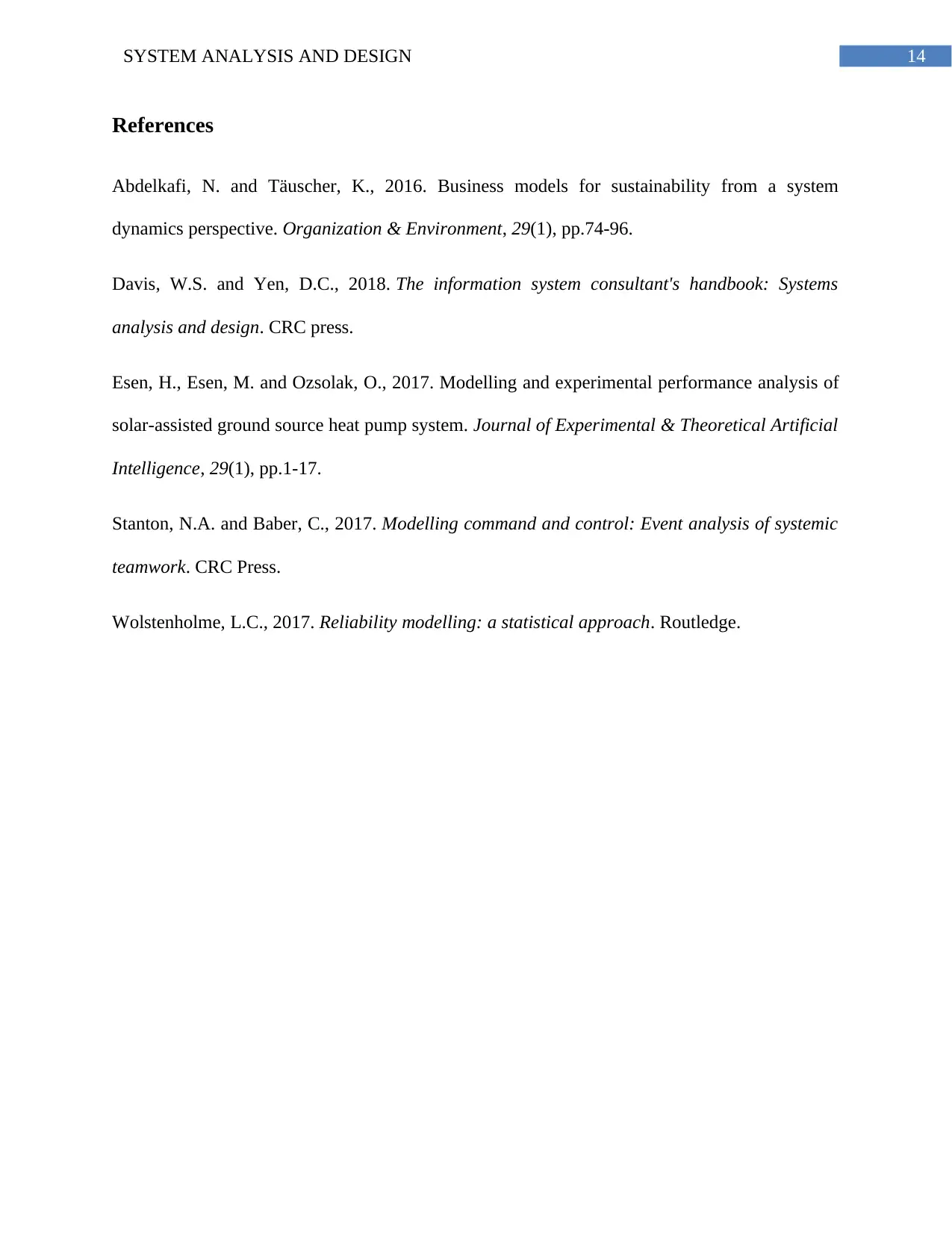
14SYSTEM ANALYSIS AND DESIGN
References
Abdelkafi, N. and Täuscher, K., 2016. Business models for sustainability from a system
dynamics perspective. Organization & Environment, 29(1), pp.74-96.
Davis, W.S. and Yen, D.C., 2018. The information system consultant's handbook: Systems
analysis and design. CRC press.
Esen, H., Esen, M. and Ozsolak, O., 2017. Modelling and experimental performance analysis of
solar-assisted ground source heat pump system. Journal of Experimental & Theoretical Artificial
Intelligence, 29(1), pp.1-17.
Stanton, N.A. and Baber, C., 2017. Modelling command and control: Event analysis of systemic
teamwork. CRC Press.
Wolstenholme, L.C., 2017. Reliability modelling: a statistical approach. Routledge.
References
Abdelkafi, N. and Täuscher, K., 2016. Business models for sustainability from a system
dynamics perspective. Organization & Environment, 29(1), pp.74-96.
Davis, W.S. and Yen, D.C., 2018. The information system consultant's handbook: Systems
analysis and design. CRC press.
Esen, H., Esen, M. and Ozsolak, O., 2017. Modelling and experimental performance analysis of
solar-assisted ground source heat pump system. Journal of Experimental & Theoretical Artificial
Intelligence, 29(1), pp.1-17.
Stanton, N.A. and Baber, C., 2017. Modelling command and control: Event analysis of systemic
teamwork. CRC Press.
Wolstenholme, L.C., 2017. Reliability modelling: a statistical approach. Routledge.
1 out of 15
Related Documents
Your All-in-One AI-Powered Toolkit for Academic Success.
+13062052269
info@desklib.com
Available 24*7 on WhatsApp / Email
![[object Object]](/_next/static/media/star-bottom.7253800d.svg)
Unlock your academic potential
© 2024 | Zucol Services PVT LTD | All rights reserved.





